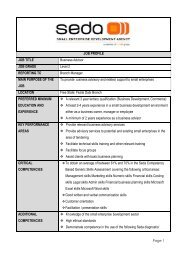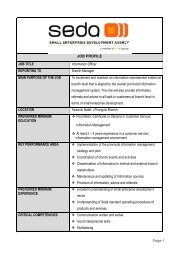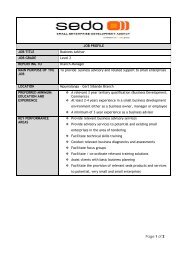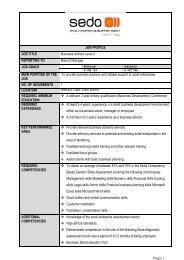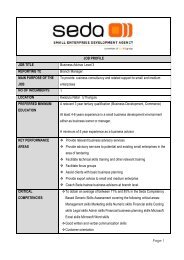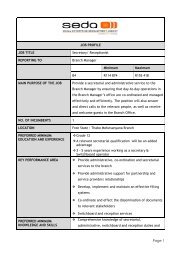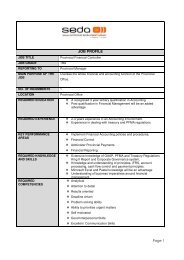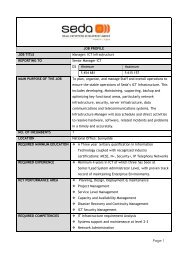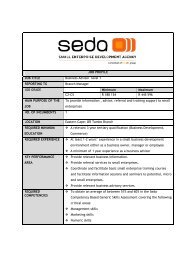Assessment of Cooperatives in the Poultry Industry - 2013.pdf - Seda
Assessment of Cooperatives in the Poultry Industry - 2013.pdf - Seda
Assessment of Cooperatives in the Poultry Industry - 2013.pdf - Seda
You also want an ePaper? Increase the reach of your titles
YUMPU automatically turns print PDFs into web optimized ePapers that Google loves.
Research Report: Address<strong>in</strong>g <strong>the</strong> Needs, Opportunities and Challenges <strong>of</strong> <strong>Cooperatives</strong><br />
and Collectively Owned Enterprises <strong>in</strong> <strong>the</strong> <strong>Poultry</strong> and Related Industries<br />
The table below illustrates <strong>the</strong> specific figures for each prov<strong>in</strong>ce.<br />
Table 2-3: Distribution <strong>of</strong> Broiler and Layer birds across South Africa<br />
PROVINCE<br />
TOTAL<br />
BROILER<br />
BIRDS<br />
% OF<br />
BROILERS<br />
TOTAL<br />
LAYER<br />
BIRDS<br />
% OF<br />
LAYERS<br />
TOTAL BIRDS<br />
% OF TOTAL<br />
EASTERN CAPE 6 875 045 6% 898 926 3% 7 773 971 6%<br />
FREESTATE 5 657 563 5% 4 675 812 18% 10 333 375 8%<br />
GAUTENG 6 961 969 6% 6 004 853 23% 12 966 822 10%<br />
KWAZULU-<br />
NATAL<br />
16 216 891 15% 4 089 376 16% 20 306 267 15%<br />
LIMPOPO 2 557 200 2% 1 542 903 6% 4 100 103 3%<br />
MPUMALANGA 21 575 970 20% 1 273 319 5% 22 849 289 17%<br />
NORTH WEST 26 943 651 25% 2 583 712 10% 29 527 363 22%<br />
WESTERN CAPE<br />
& NORTHERN<br />
CAPE<br />
22 775 800 21% 5 268 019 20% 28 043 819 21%<br />
The next section highlights a few <strong>of</strong> <strong>the</strong> socio-economic aspects <strong>in</strong>volved <strong>in</strong> <strong>the</strong> poultry <strong>in</strong>dustry. The<br />
aim <strong>of</strong> this is to assess not only whe<strong>the</strong>r <strong>the</strong>re is scope <strong>in</strong> <strong>the</strong> market for cooperatives but also<br />
whe<strong>the</strong>r <strong>the</strong>re is social benefit associated with this and whe<strong>the</strong>r <strong>the</strong>re are sufficient support<br />
mechanisms enabl<strong>in</strong>g entry <strong>in</strong>to <strong>the</strong> market.<br />
2.7. Potential<br />
The poultry <strong>in</strong>dustry is <strong>in</strong>creas<strong>in</strong>gly relevant <strong>in</strong> terms <strong>of</strong> socio-economic development, especially<br />
among previously disadvantaged South Africans. The relative affordability <strong>of</strong> poultry makes it an<br />
important source <strong>of</strong> prote<strong>in</strong> for millions <strong>of</strong> low-<strong>in</strong>come South Africans, thus contribut<strong>in</strong>g to <strong>the</strong> zero<br />
hunger ambition <strong>of</strong> <strong>the</strong> government.<br />
Small-scale farmers are common <strong>in</strong> <strong>the</strong> <strong>in</strong>dustry; as was<br />
shown <strong>in</strong> <strong>the</strong> ownership section; 49% <strong>of</strong> egg production is<br />
accounted for by SMME’s. However, ownership is not <strong>the</strong><br />
only factor to consider. A large number <strong>of</strong> small-scale poultry<br />
producers conduct bus<strong>in</strong>ess <strong>in</strong>formally. This contributes to<br />
employment and productivity <strong>of</strong> <strong>the</strong> sector but is largely<br />
unaccounted for. SAPA reports that an estimated 1554 smallscale<br />
farmers from previously disadvantaged communities<br />
An estimated 1554<br />
small-scale<br />
farmers from<br />
previously<br />
disadvantaged<br />
communities have<br />
been established<br />
19 | P a g e U r b a n - E c o n : D e v e l o p m e n t E c o n o m i s t s



